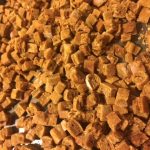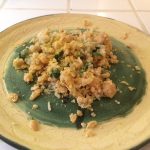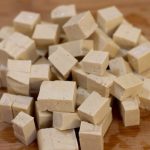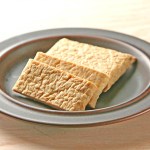Vegecat™ Recipe Instructions
Start with fresh ingredients and prepare food as you do for other family members.
If you use recipes from Dr. Pitcairn’s Complete Guide to Natural Health for Dogs & Cats, add the Vegecat™ supplement based on the following guide: Dr. Pitcairn’s Vegecat™ Recipe Modifications [pdf download]
Transition Gradually
Mix a small amount of the new food in with the old food and adjust the proportions over two weeks or longer. Digestive enzymes are especially beneficial during the transition and beyond. Let your cat show you how quickly he or she is willing to transition. Morning is the best time to begin introducing new food because the appetite is stronger. Adding extra nutritional yeast or sauces (discussed below) for flavor can help entice your cat during the transitional period.
Organic & Non-GMO Ingredients
GMO (Genetically Modified Organism) ingredients and herbicides can cause gastrointestinal issues, food allergies, and more. Soy, canola, and corn that is not organic IS almost certainly genetically modified in the USA. Compassion Circle strongly recommends organic food for you and your animals!
Digestive Enzymes
Almost every process in the body requires enzymes. Digestion is no different. Digestive enzymes are produced in the body and found in plants and raw foods. These enzymes are heat sensitive, so cooking and processing food destroys the natural enzymes. We recommend adding plant-derived enzymes (lipase, amylase, protease, and cellulase) to any cooked food. Amylase is a particularly important aid for the digestion of carbohydrates. A little raw food doesn’t supply enough enzymes to compensate for the enzyme loss in cooked food. The Compassion Circle Digestive Enzymes should be available by late Summer of 2021.
Flour for Kibble
Whole wheat and bread flour both contain 14% protein by dry weight. Gluten flour, the protein part of wheat (commonly labeled vital wheat gluten or instant gluten), contains 75% protein. The protein content in the flour used is important.
EFAs, Oils, & Substitutions
Essential Fatty Acids (EFAs) are particularly important to your cat’s well-being. Oil, flax, and hemp ingredients supply EFAs and ensure the omega-6 to omega-3 ratio is ideal.
Omega-3 fatty acid comes largely from flaxseed oil, with some from olive oil, canola oil, and/or hemp hearts. The omega-6 fatty acid requirement is largely met by olive or canola oil. Arachidonic Acid, derived from mortierella alpina, is also supplied by the Vegecat™ supplement.
Substituting oils in the recipe is not recommended. If you omit hemp hearts in a recipe, add 1 teaspoon (5mL) hemp or sunflower oil per 1 tablespoon (10g) hemp hearts omitted. You may substitute 1 teaspoon (7g) of ground flaxseed for each 1⁄8 teaspoon (0.6mL) of flaxseed oil omitted in a recipe.
Store oils in the refrigerator to avoid rancidity.
SEITAN
Each cup of vital wheat gluten flour (142g) makes about 3-1⁄2 cups of seitan (400g). Available commercially, seitan has a “meaty” consistency and absorbs flavors readily. Imitation “meat” products should have wheat gluten as the first ingredient listed to qualify as seitan.
[Organic] Soy & TSP/TVP
Textured soy protein (TSP), also known as textured vegetable protein (TVP®), or soya chunks, is defatted soy flour. TSP must be reconstituted before use by stirring in 7⁄8 cup of boiling water or low sodium broth (207mL) for each cup of TSP (105-120g). All recipe measurements for textured soy protein are for dry TSP flakes or chunks.
Use extra-firm tofu made from calcium sulfate to keep magnesium at a minimum. If using firm tofu rather than extra firm, add 1 tablespoon (10g) of protein powder for every cup of tofu or 2 tablespoons (20g) of hemp hearts to increase the protein content of your meal. Alternatively, increase the amount of tofu and decrease the grains or legumes in the recipe.
If you use soy sauce for sodium (as opposed to salt), a low-sodium soy sauce requires a 50% increase over regular soy sauce.
Hemp Hearts/Hemp Meal
You may substitute 1⁄2 a tablespoon of 100% pure protein powder (brown rice, organic soy, or hemp) per 1 tablespoon (15g) of hemp hearts to achieve the same level of protein in the meal.
Enticement & Sauces
Baby food squash makes a flavor enhancing sauce, as does canned pumpkin diluted with water, pureed cooked carrots with nutritional yeast, or pureed tahini and cooked mushrooms. Pureed canned corn with nori is also a favorite. Add a small amount of water to puree sauces.
Small amounts of crumbled nori can appeal to choosy cats, as can imitation bacon bits (without MSG) or mock meats that do not contain onion or garlic. Never feed onions and research any new ingredient to be sure there is no toxicity risk for cats.
A nutritional yeast palatability enhancer was recently removed from Vegecat™, decreasing the daily serving size by roughly half. If your cat needs that flavor, add 1 teaspoon of nutritional yeast to recipes for every 1 teaspoon of Vegecat™. You may add more if needed – to coat kibble before serving or in wet food recipes – but we recommend primarily using VegeYeast in your recipes to add acidity to the diet.
VegeYeast & Food Yeast
Food yeast is important for protein, B vitamins, and flavor. Before serving semi-moist food, dust chunks with yeast. VegeYeast (available from Compassion Circle) is a special type of brewer’s yeast made especially for cats. It has a high acid and a low magnesium content. Nutritional yeast tastes cheese-like and comes in flakes or powder. For maxi-flakes, double the volume (not the weight) measurements. Brewer’s yeast can also be used. For cats that like nutritional yeast best, use VegeYeast in the recipes for health benefits, but coat the food with nutritional yeast prior to serving.
General Info & Service with a Smile
Feed cats several times a day to assure adequate food intake. Coating food with a little nutritional yeast really can make a difference in cats accepting a plant-based diet.
Cats want fresh food. Stale, soggy, old food isn’t appreciated. Serve in clean bowls and always keep fresh, filtered water available (clean enough for you to drink). The more water and moisture in the diet, the better the urine concentration of your cat. Feeding primarily wet food recipes can prevent urinary issues.
Cats should have an acidic urine pH of 6.0 to 6.5. It is wise to test the urine at home or at a veterinarian’s office before switching the diet and about 3-weeks after transitioning to a new diet, then periodically after – twice in the first year and at least yearly after. If alkaline urine is a problem, add cranberry powder or vitamin C (ascorbic acid) to the diet. Please see the Frequently Asked Questions page of the Compassion Circle website for more information about testing urine pH at home and acidification.
Some cats are adversely affected by high dietary magnesium and exhibit urinary problems such as stone formation with too much magnesium in the diet (and often urine that is too alkaline, simultaneously). For those cats, use lower magnesium recipes.
Adult cats need from 22 to 32 calories per pound (454g) of bodyweight per day. Larger cats need fewer calories, smaller cats more. Caloric need and food consumption also depend on activity level, age, and weight. Consult your vet or an online calorie calculator to determine how many calories to feed daily. Our recipes list the number of calories the entire recipe contains. That does not change if the volume of food your recipe makes is less or more than our estimate. Follow the dry ingredient gram measures for best accuracy. You may determine how many calories are in each cup (or 100g) of your food by dividing the number of calories in the recipe by the cups (or 100g) your recipe makes. If you do not follow our recipes, add 1⁄4 tsp. (1g) of Vegecat for every 100 calories in your recipe or use the daily serving size chart on the label.
For Additional Recipes & Information, see Dr. Pitcairn’s Complete Guide to Natural Health for Dogs & Cats (4th Edition). Because the volume of the Vegecat™ supplement changed since the book’s first printing, serving size modifications are necessary. See the following URL for adjusted amounts, or simply add the supplement daily:
CompassionCircle.com/Dr-Pitcairns-Guide. A daily serving for a 10-lb (4.5kg) cat is 2⁄3 teaspoon (2.7g).
Recipe Notes
As mentioned in previously, coating kibble in squash, pumpkin, or pureed corn and nori is a wonderful way to add flavor and moisture to kibble. You may steam/cook and puree the following veggies to add to kibble or wet food recipes: corn, carrots, cucumber, peas, green beans, kale, broccoli, cauliflower, potatoes, squash, and more. It is best to avoid vegetables that are high in oxalic acid, like spinach and Swiss chard. A cat’s diet should not be more than 10% vegetable food because this will dilute the protein content and other nutrition in the recipes. Adding 1 to 1-1⁄2 tablespoons of pureed veggies per day is ideal. If your cat does not like veggies, they are not required. Adding nori flakes or algae, can add flavor and highly beneficial bioavailable nutrients. These should be kept to a minimum (1 teaspoon per day) to avoid urine alkalinity unless you add 1 teaspoon of cranberry powder or 500mg of vitamin C (ascorbic acid) per day.
We’re working to get all recipes back up after a technical issue deleted them. Please download the recipe brochure from the button at the top of the page for a complete recipe guide. Thank you for your patience!
Vegan Cat Kibble
Ingredients
- 2-1/2 cups whole wheat flour (400g)
- 1-1/4 cups bread flour (180g)
- 1-2/3 cups wheat gluten flour (200g)
- 6 tbsp hemp hearts/hemp meal (60g)
- 1-1/8 cups VegeYeast or nutritional yeast (160g) If using nutritional yeast, see label to achieve 160 grams. You may need more than 1-1/8 cups.
- 3-1/3 tbsp Vegecat (44g)
- 4-1/4 tbsp sunflower, olive, or canola oil (63g)
- 1/4 cup tomato paste
- 2 tbsp soy sauce (34g) OR 3/4 tsp salt (4g)
- 3-1/32 cups water More or less as needed.
Instructions
- Preheat oven to 300°F (150˚C).
- In a large mixing bowl, mix together all wet ingredients. We've found the entire 3-1/2 cups of water necessary but it is okay to leave some out and add later as needed.
- Separately mix all dry ingredients well.
- Add dry ingredients to wet and stir with a large strong spoon to form soft dough.
- Flour hands and counter. Knead dough until smooth and elastic. Divide into two halves. Roll out each to fit a large cookie sheet. Chilled dough rolls out easier. Work dough into corners and prick with a fork to prevent bubbles. Bake 30 minutes. Don’t brown edges.
- Remove from oven. Let cool slightly then remove from pan. Chill in freezer for 10 minutes to make cutting easier if desired.
- With a large chef’s knife or pizza cutter, cut into kibble sized pieces (like a miniature checkerboard).
- Place kibble pieces on cookie sheets.
- Dry kibble in a warm oven set at its lowest temperature. Hot sunshine works as well. Dry until the pieces are brittle and don’t yield to finger pressure (about 2 hours).
- Store in unrefrigerated covered containers.
Notes
Chickpea & TSP for Adult Cats
Ingredients
- 1-1/4 cups canned chickpeas/garbanzo beans (335g) OR 1-1⁄2 cups home-cooked chickpeas (246g), starting with 1⁄2 cup uncooked (108g)
- 3/4 cup TSP (textured soy protein) (85g)
- 1/4 cup VegeYeast or nutritional yeast (45g) If using nutritional yeast, see label to achieve 45 grams. You may need more than 1/4 cup.
- 3/4 tbsp olive oil (11g)
- 1/4 tsp flaxseed oil (1.2g)
- 1/4 tsp salt (1g) OR 1-1⁄5 tsp. soy sauce (7g)
- 2 tsp Vegecat (9g)
Instructions
- Soak garbanzo beans in water until doubled in size. Cover with fresh water and cook until soft.
- Drain thoroughly and crush warm beans with a potato masher or fork. Food processors can be used and will also crush cold beans.
- Reconstitute TSP with just under 3/4 cup water. Poor boiling water over TSP and stir. Allow water TSP to absorb water. If using larger chunks, they may need to be simmered on the stove top. See product instructions.
- Stir all ingredients together.
Notes
Lentil & Tofu for Adult Cats
Ingredients
- 2 cups cooked lentils (380g), starting with 2⁄3 cup uncooked (125g)
- 2/3 cup extra-firm tofu, tightly packed (160g/5.6oz)
- 1/4 cup VegeYeast or nutritional yeast (45g) If using nutritional yeast, see label to achieve 45 grams. You may need more than 1/4 cup.
- 3/4 tbsp olive oil (12g)
- 1/8 tsp flaxseed oil (0.6g)
- 1/4 tsp salt (1g) OR 1-1⁄5 tsp. soy sauce (7g)
- 2 tsp Vegecat (8g)
Instructions
- Soak lentils in cold water for two hours.
- Drain, cover with water, and cook until soft.
- Drain cooked lentils.
- Boiled lentils can be blended or mashed.
- Cut tofu.
- Mix all ingredients well.
Chickpea & Seitan for Adult Cats
Ingredients
- 1-1/4 cups canned chickpeas/garbanzo beans (335g) 1-1⁄2 cups home-cooked chickpeas (246g), starting with 1⁄2 cup uncooked (108g)
- 1-1/2 cups seitan (175g). Begin with 1⁄2 cup (63g) vital wheat gluten.
- 1/4 cup VegeYeast or nutritional yeast (45g) If using nutritional yeast, see label to achieve 45 grams. You may need more than 1/4 cup.
- 1-1/2 tbsp hemp hearts/hemp meal (15g)
- 1/2 tbsp olive oil (7g)
- 1/4 tsp salt (1g) OR 1-1⁄5 tsp. soy sauce (6.5g)
- 2 tsp Vegecat (8g)
Instructions
- If using dry beans, soak garbanzo beans in water until doubled in size
- Drain. Cover with fresh water and cook until soft.
- Drain cooked beans thoroughly and crush warm beans with a potato masher or fork. Food processors can be used and will also crush cold beans.
- There are a number of ways to make seitan. 1/2 cup of vital wheat gluten needs to be mixed with just under 1/4 cups of water or homemade veggie broth (made without onions or garlic). Add liquid as needed. Dough pieces can be wrapped and steamed or simmered on the stove top for about an hour. There are lots of YouTube videos that will show you the basics of making seitan. It's okay to add extra nutritional yeast for flavor but do not add extra sodium containing ingredients (salt or soy sauce), garlic, onions, or more than a tablespoon of garbanzo or wheat flour to cut 1/2 cup of vital wheat gluten for texture.
- Mix all ingredients together.
Notes
Lentil & TSP for Adult Cats
Ingredients
- 1-3/4 cups cooked lentils (340g), starting with 3⁄5 cup uncooked (112g)
- 3/4 cup TSP (textured soy protein) (80g)
- 3-1/3 tbsp VegeYeast or nutritional yeast (30g) If using nutritional yeast, see label to achieve 30 grams. You may need more than 3-1/3 tablespoons.
- 4-1/4 tsp olive oil (20g)
- 1/4 tsp salt (1.15g) OR 1-1⁄3 tsp. soy sauce (8g)
- 2 tsp Vegecat (9g)
Instructions
- Soak lentils in cold water for two hours.
- Drain, cover with water, and cook until soft.
- Drain cooked beans.
- Boiled lentils can be blended or mashed.
- Reconstitute TSP with roughly 2/3 cups boiling water. If using larger chunks, stove top simmering could be necessary. See TSP package for instructions.
- Mix all ingredients well.
Lentil & Tofu for Adult Cats
Ingredients
- 2 cups cooked lentils (380g), starting with 2⁄3 cup uncooked (125g)
- 2/3 cup extra-firm tofu, tightly packed (160g/5.6oz)
- 1/4 cup VegeYeast or nutritional yeast (45g) If using nutritional yeast, see label to achieve 45 grams. You may need more than 1/4 cup.
- 3/4 tbsp olive oil (12g)
- 1/8 tsp flaxseed oil (0.6g)
- 1/4 tsp salt (1g) OR 1-1⁄5 tsp. soy sauce (7g)
- 2 tsp Vegecat (8g)
Instructions
- Soak lentils in cold water for two hours.
- Drain, cover with water, and cook until soft.
- Drain cooked lentils.
- Boiled lentils can be blended or mashed.
- Cut tofu.
- Mix all ingredients well.
Lentils & Seitan for Adult Cats
Ingredients
- 2-1/4 cups cooked lentils (430g), starting with 3⁄4 cup uncooked (142g)
- 7 tbsp seitan (50g). Begin with 2-1⁄4 tbsp. (18g) vital wheat gluten.
- 1/4 cup VegeYeast or nutritional yeast (45g) If using nutritional yeast, see label to achieve 45 grams. You may need more than 1/4 cup.
- 1-1/2 tbsp olive oil (20g)
- 1/4 tsp salt (1.1g) OR 1-1⁄5 tsp. soy sauce (7.5g)
- 2 tsp Vegecat (9g)
Instructions
- Soak lentils in cold water for two hours.
- Drain, cover with water, and cook until soft.
- Drain cooked lentils before using.
- Boiled lentils can be blended or mashed.
- There are a number of ways to make seitan. The ratio of vital wheat gluten to water should be roughly 2 to 1. Add liquid as needed. Dough pieces can be wrapped and steamed or simmered on the stove top for about an hour. There are lots of YouTube videos that will show you the basics of making seitan. It's okay to add extra nutritional yeast for flavor but do not add extra sodium containing ingredients (salt or soy sauce), garlic, onions, or more than a tablespoon of garbanzo or wheat flour to cut the vital wheat gluten for texture. No one wants to make 7 tablespoons of seitan! Make more than required in the recipe and freeze for later use. Store bought seitan that does not contain onions and garlic is okay to use, too.
- Mix all ingredients together well.
Lentil & Tempeh for Adult Cats
Ingredients
- 1-2/3 cups cooked lentils (320g), starting with 1⁄2 cup plus 1 tbsp. uncooked (105g)
- 3/4 cup tempeh (130g/4.6oz)
- 1/4 cup VegeYeast or nutritional yeast (45g) If using nutritional yeast, see label to achieve 45 grams. You may need more than 1/4 cup.
- 1/2 tbsp olive oil (7.5g)
- 1/8 tsp flaxseed oil (0.6g)
- 1/4 tsp salt (1.1g) OR 1-1⁄5 tsp. soy sauce (7.5g)
- 2 tsp Vegecat (8g)
Instructions
- Soak lentils in cold water for two hours.
- Drain, cover with water, and cook until soft.
- Drain cooked beans before using. Boiled lentils can be blended or mashed.
- Cut or chop tempeh.
- Mix all ingredients together.
Notes
Rice & TSP for Adult Cats
Ingredients
- 1/2 cup uncooked rice (90g). Makes 1-2⁄3 to 1-1⁄2 cups cooked (260-290g).
- 1-1/3 cup TSP (textured soy protein) (95g)
- 4-1/4 tbsp VegeYeast or nutritional yeast (40g) If using nutritional yeast, see label to achieve 40 grams. You may need more than 4-1/4 tablespoons.
- 1-1/4 tbsp olive oil (18g)
- 1/8 tsp flaxseed oil (0.6g)
- 1/4 tsp salt (1g) OR 1-1⁄5 tsp. soy sauce (7.5g)
- 2 tsp Vegecat (9g)
Instructions
- Rinse rice or soak and change water.
- Cook rice with at least a 2 to 1 ratio of water to rice. Aim for soft, well cooked rice.
- Otherwise, cook according to product package.
- Reconstitute TSP with 1-1/4 cups water. If using larger chunks, possibly simmer on stove top. See product instructions.
- Mix all ingredients together well.
Notes
Rice & Tofu for Adult Cats
Ingredients
- 1/2 cup uncooked rice (74g). Makes 1-1⁄4 to 1-1⁄3 cups cooked (215-235g).
- 1-1/4 cups extra-firm tofu, tightly packed (300g/10.6oz)
- 4-1/2 tbsp VegeYeast or nutritional yeast (40g) If using nutritional yeast, see label to achieve 40 grams. You may need more than 4-1/2 tablespoons.
- 1/2 tbsp hemp hearts/hemp meal (5g)
- 1/4 tsp salt (1g) OR 1-1⁄5 tsp. soy sauce (6.5g)
- 1-2/3 tsp Vegecat™ (7g)
Instructions
- Rinse rice or soak and change water.
- Cook rice with at least a 2 to 1 ratio of water to rice. Aim for soft, well cooked rice.
- Cut tofu.
- Mix all ingredients together.
Rice, Seitan, & TSP for Adult Cats
Ingredients
- 2/3 cup uncooked rice (100g). Makes 1-2⁄3 to 2 cups cooked rice (290-320g).
- 1 cup seitan (120g). Begin with 1⁄3 cup (43g) vital wheat gluten.
- 1/2 cup TSP (textured soy protein) (25g)
- 3-2/3 tbsp VegeYeast or nutritional yeast (32g) If using nutritional yeast, see label to achieve 32 grams. You may need more than 3-2/3 tablespoons.
- 1-1/2 tbsp hemp hearts/hemp meal (15g)
- 1 tbsp olive oil (14g)
- 1/4 tsp salt (1g) OR 1-1⁄5 tsp. soy sauce (7.5g)
- 1 tbsp Vegecat (12g)
Instructions
- Rinse rice or soak and change water.
- Cook rice with at least a 2 to 1 ratio of water to rice. Aim for soft, well cooked rice.
- There are a number of ways to make seitan. 1/3 cup of vital wheat gluten needs to be mixed with just over 2 tablespoons of water or homemade veggie broth (made without onions or garlic). Add liquid as needed. Dough pieces can be wrapped and steamed or simmered on the stove top for about an hour. There are lots of YouTube videos that will show you the basics of making seitan. It's okay to add extra nutritional yeast for flavor but do not add extra sodium containing ingredients (salt or soy sauce), garlic, onions, or more than a tablespoon of garbanzo or wheat flour to cut the vital wheat gluten for texture. We highly recommend making more than needed in the recipe. You can freeze the seitan you don't use for later use.
- Add just under 1/2 cup boiling water to TSP and mix to reconstitute. If using large chunks, they may need to be simmered on the stove top. See product directions.
- Mix all ingredients together.
Oat & TSP for Adult Cats
Ingredients
- 1 cup uncooked oats (110g). Just under 2 cups cooked (480g). Check your oats and use the dry gram measure (110g).
- 2/3 cup TSP (textured soy protein) (60g)
- 4-1/2 tbsp VegeYeast or nutritional yeast (40g) If using nutritional yeast, see label to achieve 40 grams. You may need more than 4-1/4 tablespoons.
- 1 tbsp olive oil (12g)
- 1/8 tsp flaxseed oil (0.6g)
- 1/4 tsp salt (1g) OR 1-1⁄5 tsp. soy sauce (7g)
- 2 tsp Vegecat™ (8g)
Instructions
- Rinse oats and cook according to the package.
- Add just under 2/3 cup of boiling water to TSP and mix well. If using chunks they may need to be simmered on the stove top.
- Mix all ingredients together.









